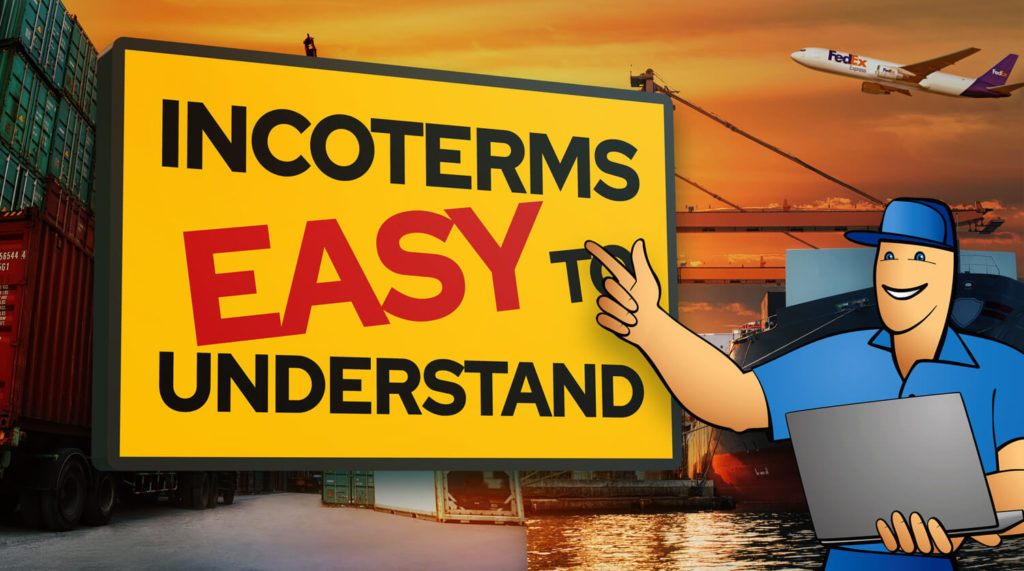Incoterms – A Simple Guide
Incoterms or International Commercial Terms are used to facilitate and standardize trade processes, especially logistics and shipping. As of today, there are 11 different Incoterms that all allocate different responsibilities to both parties of a transaction.

You can also listen to this article:
What are Incoterms?
Incoterms or International Commercial Terms are an industry standard that is used to regulate international trade. They provide a legal framework for commercial transactions and procurement processes, defining the responsibilities and obligations of the sellers and buyers, mainly in the logistics and shipping phase of a transaction.
There are 11 Incoterms today that define some of the aspects and processes of a transaction so that the tasks, costs, risks, and responsibilities would be well understood by both parties. Some of the terms defined in Incoterms are:
- Delivery. This specifies the point where the legal risk of loss or damage is transferred from seller to buyer.
- Transportation costs. This specifies which party pays for any of the transportation necessary for delivering the goods.
- Export/import documentation. This specifies which party deals with the formalities and documentation related to import/export.
- Insurance costs. This specifies the party that takes care of the insurance costs.
They do not, however, include information about the products, lead times, their price, or payment terms, nor do they provide dispute resolution mechanisms. That is why Incoterms need to be complemented with separate terms that address other conditions of the sale while the terms should be managed within a procurement software.
The first set of Incoterms was published by the International Chamber of Commerce in 1936 and since then they have been periodically reviewed and amended. The current version – Incoterms 2020 – is the ninth edition of Incoterms and it was published on September 10, 2019.
Classification of Incoterms
There are two basic methods for categorizing Incoterms: the first is by the nature of the terms, the other by the means of transportation used. In the case of the latter, the differentiation is made between Incoterms for any mode of transport and Incoterms only for sea and inland waterway transport. The other distinction divides the Incoterms into four categories:
- Category E contains only one term: EXW (Ex Works).
- Category F contains three terms: FCA (Free Carrier), FAS (Free Alongside Ship), and FOB (Free on Board).
- Category C contains four terms: CPT (Carriage Paid To), CIP (Carriage and Insurance Paid to), CFR (Cost and Freight), CIF (Cost, Insurance and Freight).
- Category D contains three terms: DAP (Delivered at Place), DPU (Delivered at Place Unloaded), DDP (Delivered Duty Paid).
These categories relate to how the responsibilities and risks are allocated between the two parties of the transaction. While category E imposes a minimum set of obligations on the supplier, category D indicates the opposite: most of the responsibilities and risks are put on the supplier while the buyer has little to worry about.
Basic features of Incoterms
As previously mentioned, one of the general distinctions made between different types of Incoterms refers to the mode of transport. Let us take a look at the Incoterms by dividing them into those two groups.
Incoterms used for all modes of transport:
EXW Incoterm
The EXW or the Ex Works Incoterm makes the buyer responsible for the whole journey. The seller only has to make the products available at an agreed-upon time at an agreed-upon location (usually the seller’s place of business). If the location is not specified in the contract, the seller can choose a suitable location themselves. The buyer has to organize the loading and clear the goods for export, if necessary. The buyer also assumes all risk of loss or damage as well as the costs as soon as the goods are delivered, i.e. made available at the seller’s location. No insurance is required within the EXW framework.
A good example of the use of EXW Incoterm is a courier shipment where the buyer pays a courier company to pick up the goods from the premises of the seller. EXW is mostly used for domestic trade.
FCA Incoterm
FCA or the Free Carrier Incoterm either makes the seller responsible for loading the goods onto the buyer’s transportation or for transporting the goods to a predetermined place of delivery where the goods are given over to a carrier arranged by the buyer. In the latter case, the seller does have to load the goods to their vehicle and take them to the agreed-upon location but is not responsible for unloading the items there. However, the FCA Incoterm requires the seller to clear the goods for export, if necessary. Clearing for import remains the responsibility of the buyer. In the case of the FCA Incoterm, insurance is not required.
CPT and CIP Incoterms
CPT or the Carriage Paid To Incoterm specifies that the seller has to pay for the delivery of goods to a specified location, usually the buyer’s facility or a port of destination. However, the buyer assumes all risk of loss or damage as soon as the goods are loaded onto the first carrier’s transportation vehicle at the seller’s facility.
The CPT Incoterm also obliges the seller to clear the goods for export while the buyer needs to clear them for import. No insurance contract is required within the CPT framework.
CIP or Carriage and Insurance Paid To Incoterm retains the features present in the CPT, but with the additional requirement of insurance. After the 2020 revision, the insurance has to cover the contractual price plus 10%, if not agreed upon otherwise. The seller has to provide the insurance.
DAP, DPU, and DDP Incoterms
DAP or the Delivered At Place Incoterm is mostly used in situations where the parties do not want the seller to be responsible for the unloading of goods at the destination. In this case, goods are considered delivered when the vehicle arrives at the buyer’s facility. Until then, the seller assumes risk of loss or damage.
DPU or the Delivered At Place Unloaded Incoterm, however, specifies that the seller is also responsible for the unloading of the goods at the place of destination.
In both cases, the seller is responsible for the export formalities and the buyer for the import formalities.
DDP or the Delivered Duty Paid Incoterm, however, specifies that the buyer is obligated to unload the goods, but the seller has to clear the merchandise for both export and import.
No insurance is required within any of the three D-category incoterms.
Incoterms for sea and inland waterway transport:
FAS and FOB Incoterms
FAS or the Free Alongside Ship specifies that the buyer has to organize and pay for the transportation from port to port. The goods are considered delivered when they are placed alongside the buyer’s vessel at the port. From that moment on, the buyer has to bear all costs and risks. Within the FAS Incoterm framework, the seller has to clear the goods for export and the buyer has to clear the goods for import, if not agreed otherwise. FAS should be used only for non-containerized seafreight and inland waterway transport.
Under the FOB or the Free On Board Incoterm, the seller also has to load the goods onto the vessel of the buyer. That means the risk of loss or damage is transferred to the buyer only when the goods are on board the ship. Like with the FAS, the seller has to clear the goods for export and the buyer for import.
No insurance is required from either party under either of the Incoterms.
CFR and CIF Incoterms
CFR or the Cost and Freight Incoterm specifies that it is the obligation of the seller to load the goods onto the ship, after which the risk of loss or damage is shifted onto the buyer. However, the seller still has to organize and pay for the transport to the destination port. The seller has to clear the goods for export and the buyer for import. In the case of the CFR Incoterm, no insurance is needed.
CIF or the Cost, Insurance, and Freight Incoterm retains the basic features of the CFR Incoterm, but adds the requirement of insurance for the journey from the port of shipment to at least the port of destination.
Key takeaways
- Incoterms or International Commercial Terms are an industry standard that is used to regulate international trade, defining the responsibilities and obligations of the sellers and buyers, mainly in the logistics and shipping phase of a transaction.
- There are 11 Incoterms today that define some of the aspects and processes of a transaction, including delivery, transportation costs, import/export formalities, and insurance costs.
- Incoterms do not include information about the products, their price, or payment terms, nor do they provide dispute resolution mechanisms. That is why they need to be complemented by separate terms that address other conditions of the sale.
- Incoterms are categorized either by the nature of the terms or the mode of transport used (all modes of transport vs. sea and inland waterway transport).
- Under the Ex Works (EXW) Incoterm, the buyer picks up the goods at the location of the seller, taking over all transportation costs as well as the risk of loss or damage.
- The Free Carrier (FCA) Incoterm specifies that the seller loads the goods onto the vehicle of the carrier, the risk and costs pass onto the buyer when that is done.
- Under the Carriage Paid To (CPT) Incoterm, the seller has to pay for the transport while the buyer assumes the risk for any loss or damage incurred. In the Carrier and Insurance Paid to (CIP) Incoterm, the seller also has to pay for insurance.
- Under the Delivered At Place (DAP) Incoterm, the seller is responsible for delivering the goods to the facility of the buyer, without having to unload the goods. The Delivered at Place Unloaded (DPU) Incoterm also requires the seller to unload the goods, with the risk being transferred to the buyer once the goods have been unloaded.
- The Delivered Duty Paid (DDP) Incoterm puts the responsibility for clearing the goods both for export and import onto the seller, who also has to organize the delivery to the facility of the buyer, without unloading the items.
- Under the Free Alongside Ship (FAS) Incoterm, the seller has to place the goods alongside the carrier ship, after which the risk and costs are transferred to the buyer.
- The Free On Board (FOB) Incoterm specifies that the seller is also responsible for loading the goods onto the carrier vessel.
- Under the Cost and Freight (CFR) Incoterm, the seller has to deliver the goods to the port of destination while the risk of loss or damage shifts to the buyer when the goods are loaded onto the vessel. The Cost, Insurance, and Freight (CIF) Incoterm adds the requirement of insurance, paid for by the seller.
You may also like: Supply Chain Planning – A Quick Guide




